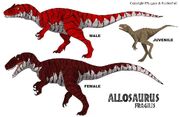
Illustration by FeatherTail of JPLegacy.
Physical Characteristcs[]
Length: 40 feet
Height: 14 feet
Weight: 2.5 tons (females); 2 tons (males)
Coloration:
- Male: A vibrant red with black stripes along back.
- Female: A less prominent red or even maroon, still with the stripes.
- Juvenile (both sexes): Light brown with thinner versions of the stripes.
Diet[]
Small to Medium-sized prey, such as ornithopods and Stegosaurus. However, packs can tackle youpng or weak sauropods, commonly Apatosaurus.
Preferred Habitat[]
Preferred Habitat: Sparse forests and open grassland. It is the need for open space to enable Allosaurus to run after its prey that this dinosaur does not inhabit the more densely forested areas of Sorna.
Social Structure[]
Social Structure: Allosaurus males and sub-adults of either sex are often nomadic and may form small hunting packs. Such packs will often trail after migrating sauropod herds, waiting to take out the young or weak members that stray too far from the security of healthy adults. Allosaurus packs do not exhibit complex pack structure and hierarchy, although largest individuals tend to dominate over smaller ones. Packs can stay together for decent periods of time as long as food is plentiful. Mature females tend to be more territorial and prefer to live alone, although it is not unheard of for adult females to display packing behavior.
Breeding Season[]
Dry season, when males take advantage of the migrating sauropods to hunt the weaker individuals as they travel to the Meadow to lay their eggs. Well-fed and brimming with confidence, stronger males enter the territory of females in pursuit of a mate. Eggs hatch at beginning of wet season.
Description[]
Large, bipedal carnivore. Slightly smaller than Tyrannosaurus although not as robust and more lightweight. Sleek anatomy promotes speed and agility, top speed 50mph for short distances. Front limbs long and well-muscled, with grasping three-fingered hands tipped with eagle-like talons, used for maiming prey. Paired crests over each eye, larger in males. Females larger and more robust than males.
Behaviors[]
Allosaurus is an active hunter, capable of taking down prey many times its own size. Its head is not as strong or robust as those of Tyrannosaurus and its bite force is weak compared to its body size, therefore the jaws cannot hold onto struggling prey or crush bone. However, the jaws can open extremely wide. Hunting Allosaurus will run up to their prey, then use their upper jaw like an axe to hack and slash at the victim before backing away; repeating the process to weaken the victim until it dies of blood loss. Allosaurus is typically reckless when hunting, especially when in a pack. Broken bones are a common occurrence, however Allosaurus is surprisingly tough and durable, able to survive injuries that could kill other animals and which heal at an extraordinary rate.
Breeding Behaviors[]
Allosaurus possess a very distinct call, sounding like the blast of a trumpet mixed with the roar of a lion. A receptive female will typically call out for a mate; often the only time she readily invites males to enter her territory. Males seeking out females are often forced to compete with other males and extremely vicious fights can occur. Female Allosaurus are larger than males, and highly aggressive. They are also very fussy and may attack unsuitable males without warning. A male will approach with caution; showing off his eye crests to the female in attempt to impress her. He also produces a pheromone from glands near his eyes- the theory is that this puts her at ease although it does not always work. If the male is successful, however, he will make a hasty exit as soon as mating is over.
The Allosaurus female will lay her eggs in a mound constructed of loose dirt, similarly to the nests of crocodiles. When she hears her young squeaking, she will help free them by carefully digging them out of the mound with her talons. Female Allosaurus are attentive mothers, guarding their young and bringing them food until they are old enough to look after themselves. Depending on the disposition of the female, she may allow her young to remain with her into sub-adulthood and possibly even adulthood, thus forming familial packs (more common when prey is abundant). The more aggressive, territorial females are different however; once the maternal bond is severed she will show no interest in her offspring, and if they stay around for too long, she may even perceive them as potential prey.
Resources[]
Page Illustration by Feather Tail Text from LtL Isla Sorna Field Guide
